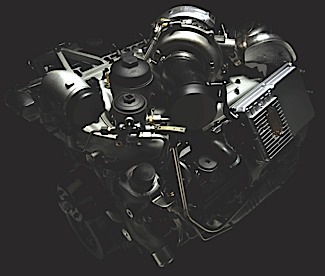 By Bob McDonald
By Bob McDonald
A phrase that I often hear from customers is, “This is a diesel engine; the problem should be easy to diagnose.” The right part about that statement is that the customer realizes that he has a diesel engine.
Certainly, there are some common repairs needed on specific engines that are easy to do, but that doesn’t mean everything else will be easy to diagnose. Owners often think that because diesel engines are now computer-controlled, the technician should be able to hook up a scan tool and immediately see what is going on.
The good thing about electronic diesels is that the technician can link up with a scan tool to analyze data in order to try to pinpoint problems. But some problems may be tougher than your customer — or you — think. Take the diagnosis of an injector issue.
 The most common injector issue is when the engine produces a cylinder misfire. The misfire is generally associated with a loss of power and no unusual smoke.
The most common injector issue is when the engine produces a cylinder misfire. The misfire is generally associated with a loss of power and no unusual smoke.
Like anything else, injectors can get tired and become weak over time.
Even though they are electronic, sometimes the mechanical components inside the injector may also become worn, cease to function properly and even fail.
In cases such as these, the scan tool generally will pinpoint the cylinder with the contribution problem.
However, injectors can fail in ways other than becoming just worn out or tired. One of the most common failures occurs when an injector body becomes cracked. When the body is cracked, the engine will not necessarily produce a miss but will cause other problems, which can be even more difficult to pinpoint.
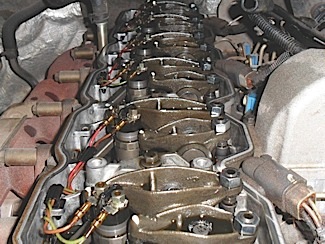 Although the injector body can be cracked, the engine may still run fine but just take an extended period of time to crank.
Although the injector body can be cracked, the engine may still run fine but just take an extended period of time to crank.
In addition, the customer may notice some fuel dilution in the oil by seeing that the oil level is rising on the dipstick. When the engine is shut down, the crack in the injector’s body will often cause fuel to drain back from the fuel lines and rails back to the tank. When the leak down occurs, the engine has to spin over for an excessive period of time in order to re-prime the injection system.
Crank Time
A normal crank time in a common-rail injection system is usually around three to five seconds. This is how long it will take the common-rail pump to build fuel pressure to the “threshold.” The threshold for cranking is when the fuel rail pressure reaches around 5,000 psi. Normal common-rail systems will operate at 5,000 psi at idle and can reach up to 30,000 psi at wide open throttle (WOT).
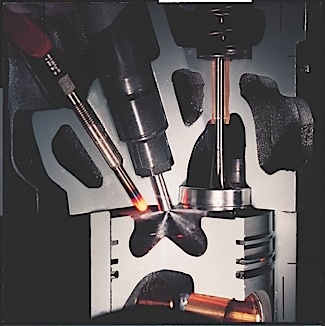 In a Cummins engine, the injectors are not actuated by the controller until the fuel rail pressure reaches the threshold. So when an injector becomes cracked and the fuel has leaked down in the injection system, crank times will become almost tripled in order for the fuel system to re-prime and the desired threshold reached in order to fire the engine.
In a Cummins engine, the injectors are not actuated by the controller until the fuel rail pressure reaches the threshold. So when an injector becomes cracked and the fuel has leaked down in the injection system, crank times will become almost tripled in order for the fuel system to re-prime and the desired threshold reached in order to fire the engine.
So how do you determine which injector may have a possible crack? This can be a lengthy process to determine exactly which injector is the problem.
Cummins recommends a simple visual test to start. First remove the valve cover, then crank the engine and let it idle. With a light, study the injector body of each cylinder. Sometimes, if the injector body is cracked externally, you may be able to notice a small wisp of smoke from the injector.
The wisp of smoke that can sometimes be seen is actually the atomization of fuel being released from the crack. But this wisp should not be confused with blowby, which will be seen also. If the injector is cracked externally and producing a smoke wisp, you will be able to smell the hint of diesel fuel in the air.
This type of diagnosis can be very useful in trying to identify which injector may have an external crack. But what if you still can’t determine which one is the problem child? Then you’ll have to dig a little deeper and isolate each cylinder. The only way that you can isolate an individual cylinder is to cut off the supply of fuel — in order to do this in a common-rail system you’ll have to cap it off. 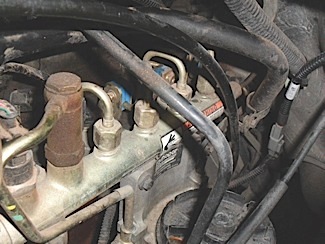
For the Cummins engine, I start with the first cylinder and remove the hard line between the fuel rail and injector.
Next, I place the cap on the fuel rail where the fuel line was.
(A word of caution here: this “cap” is a special tool made by Cummins specifically for this test. This cap is made to withstand the high pressures associated with a common-rail system. Do not use anything else or you may suffer injury or death from the high-pressure fuel.)
Next, I crank the engine and see if the crank time is reduced. If not, I proceed to the next cylinder until I can determine which one is responsible for the long crank time.
I have worked on trucks in which the Cummins engine would not run at all. This usually happens when the injector is cracked so badly that the fuel system can never reach the threshold. The oil will also be heavily diluted with diesel fuel. By installing the cap on each cylinder one at a time, the bad injector can be isolated — you’ll know you’ve found it when the engine fires normal and fast.
Whether you’re dealing with a 5.9L or a 6.7L engine, you should understand the process of elimination of each injector on common rail Dodge Cummins applications in order to isolate leaking injectors. GM’s Duramax applications are totally different as are Ford PowerStrokes, because the right scan tool can read leakage rates of each injector; with Cummins applications they cannot.
Loss of Power on PowerStroke
And while advanced engine electronics and today’s diagnostic tools have made it easier to pinpoint driveability problems in diesel engines, it doesn’t mean that all problems are solved so easily. 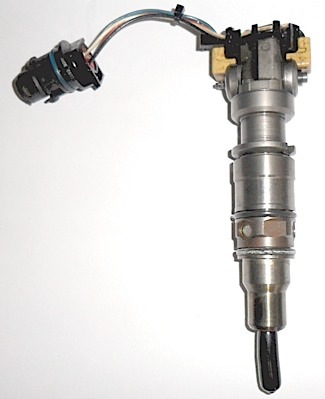
A great example is one that came by the shop the other day. The owner had an ’03 6.0L PowerStroke that had lost power. When he pulled into the parking lot I could hear that the engine had an audible miss. The first thing was to reach for the scan tool and see what trouble codes were found.
Also, some engine parameters needed to be checked to see if other engine components were doing their jobs. All of the engine parameters looked okay. In fact, you really could not ask for the data to look any better. But why did the engine have such a terrible miss?
Next, I took a look at the trouble codes. There were codes pointing to the fact that cylinders 1, 3, 5 and 7 had a contribution problem. This was more or less saying that these cylinders were dead. So, how bad was the engine missing?
One thing that is common on the 6.0L DIT engines is what is known as injector stiction. Now, I didn’t know if this was the problem, so I had to probe a little deeper.
First of all, you need to understand how the injector functions. In the top of the injector is what is known as a spool valve. The spool valve is controlled by two 48-volt, 20-amp coils that direct oil flow in and out of the injector.
One coil is used to open the oil circuit and the other is used to close the oil circuit. Basically, you have the spool valve in the middle with a coil on each end. When the open coil energizes, the spool moves one way and when the closed coil energizes the spool moves the other way. 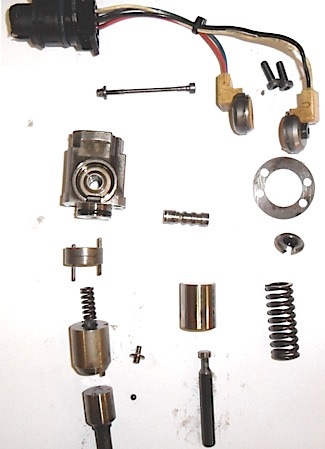
This movement of the spool valve is only 0.017˝. When the open coil is energized, the spool valve moves to allow high-pressure oil in from the rail to flow into the injector. When the closed coil is energized, oil is allowed to drain from the injector into the crankcase.
The coil is energized by the FICM (fuel injection control module) for 800 millionths of a second. Think about that: it is impressively fast to move a spool that quickly when it is under the intensity of high-pressure oil.
So when the spool opens, high-pressure oil enters the injector. This, in turn, pushes the intensifier piston and plunger downward inside the injector body. Fuel enters the injector through an opening on the side of the injector body, which is delivered by the fuel pump and surrounds the injector through passages in the cylinder head.
At idle, the high-pressure oil is around 600 psi. When the engine is at WOT, the high-pressure oil can reach 3,000 psi. So, as the piston and plunger move downward inside the injector, fuel in the bottom chamber of the injector is being squeezed. The intensifier piston is seven times greater than the surface area of the plunger. This means that the injection force will be seven times greater than the high-
pressure oil.
Put it this way: let’s say the engine is at idle and the high-pressure oil is at 600 psi. When the open coil is energized, the high-pressure oil comes into the injector and the piston and plunger move downward. The pressure of the fuel in the delivery chamber being forced through the tip of the injector nozzle will be 4,200 psi. Now realize that if the engine is at WOT, this would be 21,000 psi!
But, what is injector stiction and how does it relate to the injector? Injector stiction has to do with the injector spool valve. When the FICM commands the injector to open, there can be a delay in the spool valve movement, usually from the spool valve sticking in the bore.
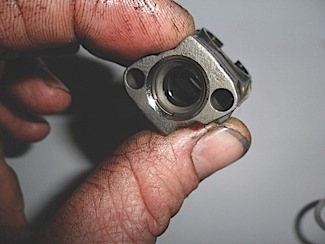 Check the Oil
Check the Oil
There are several things that can cause stiction of the spool valve. One of the biggest culprits is the type of oil being used along with the viscosity. These engines can be very picky about oil. It is not that there are bad oils on the market, but some are better for this engine than others.
As you can see, these engines use hydraulic pressure to operate high injection pressures. One thing that tends to influence hydraulics is the amount of air that can be entrapped in the oil. It doesn’t matter if we’re talking about an earthmover, hydraulics do not like air. Air in the oil causes foam. When foam enters the injector, it will cause misfires and rough running due to the “fake” injection pressures the foam is producing.
One thing that you have to remember is that all of the oil is going to foam after being churned by the pump and slung around in the engine. But, there is only one way to release the foam: manufacturers use silicone as a release agent. So most of the time, I will use the engine oil that the manufacturer recommends. Manufacturers of vehicles know what the engines need and have to stand behind their products.
If you are using the oil that is recommended by the manufacturer, then hopefully you are also changing it by the manufacturer’s recommendations. Sometimes injector stiction is caused by negligent servicing of a vehicle. Deposits and scum tend to build and leave behind debris that can cause the spool valve to stick. Of course, over a period of time, the coils in the spool valve can also fail, resulting in a dead injector. So in order to give the best service life for your engine, follow the recommendations of the manufacturer.
Start Your Scanning
Going back to diagnosing, you have to have the proper tools. There are scan tools on the market that will show a lot of data along with the trouble codes. There are also scan tools used by the dealer, which we often can’t afford. But in order to find out what is happening with the 6.0L injector, you need a tool that can actually see the injector spool times.
While there are many diagnostic tool options available out there, one tool that I have found in the aftermarket for independent garage is from Hickok Inc. It’s called the G2 Diesel Injector Tester and is for diagnostics used on-board while the engine is running.
I’ve found this tool is helpful in diagnosing 6.0L injector issues, as well as saving the customer some money. The reason for this is that a lot of times when you have a couple of injectors that may have issues, some shops feel they have to replace them all. As you know, diesel injectors are expensive and this can be very costly.
With a tool like the G2, you can see which injectors are causing the problem and replace only the ones that are bad. With the use of a laptop computer along with the G2 tester, injector spool times are identified quickly. While a laptop is not necessarily needed, it will give some data logging capabilities along with some graph displays on what the injectors are doing.
Going back to the ’03 truck that had come into the shop, I knew that I had problems in cylinders 1, 3, 5 and 7. The trouble was all on the passenger-side bank. After hooking up the vehicle to the G2, I was able to get an idea of what was going on. The spool times of the injectors looked great. The funny thing was that these injectors’ spool times looked great compared to others I had seen in the past, but the engine still had a miss on four cylinders.
The next thing was to perform a cylinder kill test, which can also be done with the G2. The purpose of the test is to find out how all the cylinders deviate from each other in order to see their contribution to the total engine. The cylinder kill test will obtain a baseline while the engine is running. After the baseline of rpm and torque, the G2 will kill cylinders 1 through 8 in order for several seconds.
After the test, we found that cylinders 1, 3, 5 and 7 were not contributing anything — in other words, those cylinders were completely dead. So there was one other thing that needed to be looked at. I wanted to see what the HPOP (high pressure oil pump) was doing. From the menu of the G2 you can also select to display and graph the pressures of the HPOP.
After running the vehicle for a few minutes graphing the HPOP data, I could not find anything wrong. The pressure at idle was almost 600 psi and would rise as I accelerated the engine. So it was evident that there was nothing wrong with what could make this engine function.
The only other thing that I could do would be to pull the passenger-side valve cover and take a look. Something to keep in mind on a 6.0L is that, if all things are working, there must be a high-pressure oil leak somewhere. Seeing as how all of the cylinders were dead on one side, there had to be a leak somewhere.
After removing the valve cover, I cranked the engine once again to see if there were any external signs of leakage. Unfortunately, there was not, so the engine had to be torn down further. What I found was the oil branch from the HPOP on the passenger side was leaking. This was causing such a loss of high-pressure oil that the injectors could not actuate when they were pulsed by the FICM.
While tearing down the engine and using my diesel injector tester, I found that someone had already replaced all the injectors on the passenger side. The owner admitted that he had just picked up the vehicle from another shop that could not fix it. With the PCM having codes pertaining to possible injectors, the shop automatically assumed that new injectors would fix the problem. This was a terrible choice for both the owner and the previous shop.
Obviously, the best thing to keep in mind is that there are tools out there related to certain purposes that will do a much better job saving the job — and your reputation — than trial and error.
While you may realize it, you may have to remind your customers that there have been great technological advances in diesel design, but it doesn’t mean that it has become simple. I think sometimes with newer diesel engines, owners may think that there are easier ways in determining failed parts, but it can be still just as aggravating as older diesel engines. Some things still may have to be done the old-fashioned way in order to properly diagnose engine complaints.
One other thing that hasn’t changed: when you find injector issues such as these, be sure to tell the owner about the additional labor that is likely to be involved in the bill for your expert diagnosis.













